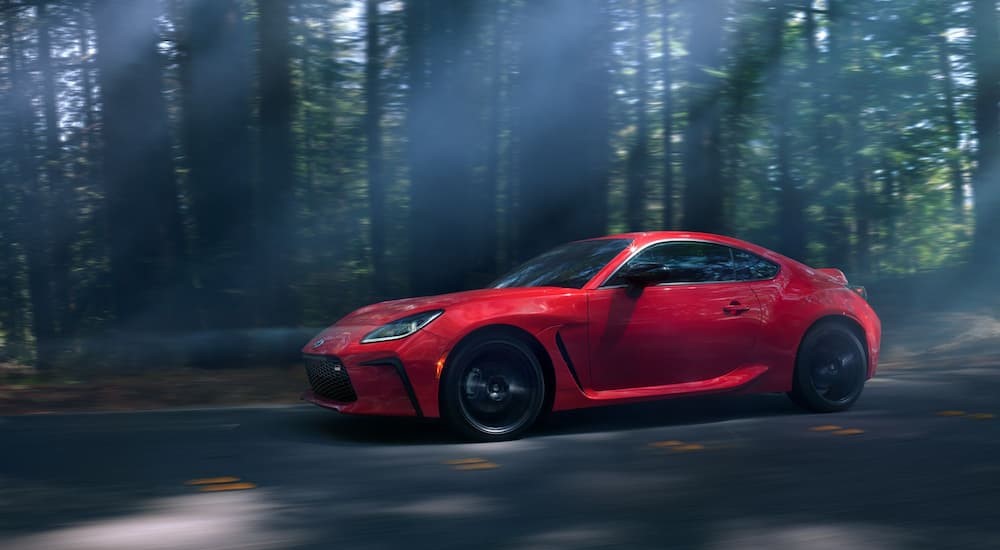Walk into your local Oswego Toyota dealer, and you’re sure to find a car, truck, or SUV to suit any driver or driving style. From family-friendly SUVs to dynamic sedans and hard-working pickups like the Tundra and Tacoma, the Toyota lineup has something for everyone, including those who aren’t afraid to flirt with a little redlining. Speed freaks rejoice because Toyota has you covered in the form of the GR86.
With its sporty styling, high-performance credentials, front-engine/rear-wheel-drive design, and sheer affordability, the Toyota GR86 is one of the brand’s standout creations. Since 2012, the Toyota 86 has been turning heads and instilling jealousy in nearby drivers while giving Toyota fans a true performance model to call their own. The 86 has never been hurting for power, but when a new second-generation model debuted in 2021, the sports coupe was graced with a two-letter prefix that singles it out as a model that puts performance above all else—GR. So what do these two letters bring to the party, and why do they suggest that the newest version of the 86 might be the most thrilling to date? We’ll answer all that and more as we take a lap in one of Toyota’s most outstanding automotive creations.
A New Image
So, what makes the GR86 such a special model? All the information you need is right there in the name. GR86 isn’t some slick moniker developed by a focus group or marketing team: the characters “GR” and “86” actually hold great importance within the wider Toyota culture.
We’ll start with GR, which is short for Gazoo Racing. While many automakers have a separate, in-house racing or performance division that occasionally lends its name to production-level models, Toyota once had three: Toyota Racing, Lexus Racing, and Gazoo Racing (GR). These in-house brands were known for creating souped-up, race-ready versions of some of their respective automaker’s most popular models, with each division focusing on its own specific racing series or event. As far as the Japanese automaker was concerned, Toyota Racing was focused on Formula One while Lexus Racing competed in the World Endurance Championship (WEC), but what about Gazoo Racing?
The year was 2007, and a team of Toyota mechanics entered the famously grueling Nurburgring 24 Hours race with two Toyota Altezzas in tow. Barred from using the Toyota Racing name for the new venture, the team settled on a unique handle that had its roots in a little-known Toyota website. “Gazo,” which means “picture” or “image” in Japanese, was the inspiration for gazoo.com, a photo-based website where Toyota could post used vehicles for sale. On its surface, the name might not make a ton of sense, as GR’s creations were anything but used, but it has to do with a curious evolution of the term. Toyota engineers started using the word to describe a mental image—or “gazo”—of garages filled with unique, high-performance models. While Japanese does have a word for garage that was actually adopted from the English—“gareji”—gazo became shorthand for “garage” amongst Toyota engineers. “The ultimate goal of the various garages, each with a different focus, is to create better cars,” said Koei Saga, chief officer and technical director of Toyota Gazoo Racing.
When the Nurburgring 24 Hours race team was searching for an appropriate moniker, “Gazoo” was the obvious choice. Team Gazoo didn’t exactly take the event by storm with 104th and 110th place finishes, but the race was an important step in the evolution of Gazoo Racing.
The GR team would return to the Nurburgring 24 Hours race for the next couple of years, but it got a real shot in the arm in 2009 when new Toyota president Akio Toyoda made the racing division more of a priority. Toyoda expanded Gazoo Racing’s scope in 2015, reorganizing all three Toyota racing divisions under the GR umbrella. The newly expanded brand has already notched some impressive achievements over the last decade, earning a coveted Le Mans win and producing some of the most exciting Toyota models to date.
GR Creations and the Origin of “86”
The first GR creation to hit the streets was the 2019 GR Supra, an even higher-performance version of the company’s storied sports car. Catering to hot-hatch-obsessed JDM fans worldwide, the 2020 GR Yaris was the second Toyota model to wear the GR badge. A performance-oriented version of the Yaris subcompact hatchback, the GR Yaris also allowed Toyota to meet the World Rally Championship (WRC) homologation rules to certify it as road-worthy and meeting WRC criteria. The GR86 would join the lineup in 2021, followed by the GR Corolla in 2023.
As far as the “86” is concerned, you can credit the Toyota Corolla GT coupe of the mid-1980s. The rear-wheel drive Corolla was a hit with tuners and racing enthusiasts alike, thanks to its low weight, easy modification, five-speed manual transmission, MacPherson strut front suspension and optional limited slip differential. That said, it was probably the Corolla GT’s front-engine/rear-drive layout that made it such a standout in an era where such configurations were becoming increasingly rare. The Corolla GT won its fair share of plaudits and trophies throughout the ’80s and early ’90s, including making off with back-to-back British Touring Car Championship trophies in 1986 and 1987.
The number 86 was part of the Corolla GT’s AE86 chassis code, but the two-digit number quickly became the go-to slang for the model itself amongst Toyota fans. Also called the “Hachi-Roku”—“Eight-Six” in Japanese”—the Corolla GT was the affordable sports coupe of its time. Given that the GR86 aims to fill a similar role in today’s market, the 86 designation was a no-brainer for the Toyota team.
Teaming Up
The GR86 is a bit unusual as far as the brand’s projects are concerned. Instead of retooling an existing Toyota model into a high-performance GR version, Toyota started from the ground up by envisioning an entirely new front engine, rear-wheel drive sports car with a 2+2 seating layout, but it was a collaboration with Subaru that would see the GR86 come to fruition. In 2008, Toyota purchased 16.5 percent of Fuji Heavy Industries, a conglomerate that also happens to own the Subaru brand. The acquisition spurred Toyota project leader Tetsuya Tada to invite Subaru to team up on a new project powered by a new D-4S boxer engine that would be co-developed by the two Japanese auto brands. While Subaru initially rejected the proposition due to its reputation for producing nothing but all-wheel drive vehicles, a successful prototype test led the automaker to reconsider. Powered by the co-developed D-4S boxer engine and built on a chassis inspired by the Subaru Impreza, the FT-86 Concept debuted at the 2009 Tokyo Motor Show.
The FT-86 Concept would be followed by a turbocharged FT-86 G Sports concept at the 2010 iteration of the Tokyo event, featuring a fresh slate of new aftermarket accessories—carbon fiber panels, vented hood, rear wing from Toyota’s new G Sports line of accessories—and the FT-86 II Concept in 2011. Subaru would roll out a similar model appropriately dubbed the BRZ Prologue at the 2011 New York International Auto Show, but it would be another year before drivers could get behind the wheel of an actual production model.
The first-generation Toyota 86/Subaru BRZ debuted for the 2012 model year and featured a lightweight aluminum hood and a low-mounted boxer engine that gave the sports car a low center of gravity and superb driving dynamics. Speaking of the engine, a naturally aspirated flat-four combined the best of Subaru’s boxer approach with Toyota’s D-4S fuel injection system to create a 2.0-liter engine producing 200 horsepower and 151 lb-ft of torque. These numbers might sound relatively tame, but when you factor in the sports car’s sub-3,000 lb curb weight, the engine gave the 86 an admirable power-to-weight ratio that made for an exceedingly fun drive.
The GR name came into the picture in 2021 when Toyota rolled out the second-generation model. Initially called the GR 86, Toyota nixed the space later in the year to give the sports car its final GR86 designation. The later model includes a number of improvements over the first 86 with Toyota expanding the use of lightweight aluminum to the roof and front fenders and folding in components from the Subaru Global Platform, giving the sports car 50 percent more torsional rigidity in the process.
The Toyota GR86 is back and better than ever for 2024. Starting at just $30,000 for the Base trim, the GR86 is a true value in its segment, allowing drivers to experience the thrill of its front-engine/rear-wheel drive setup and 228-horsepower, flat-four engine without breaking the bank. Those who like to row their own gears will also appreciate the available six-speed manual gearbox, which is an increasingly rare sight in today’s market. All in all, the GR86 is one of Toyota’s most intriguing creations to date, but the brand always goes out of its way to keep the sports car fresh between model years.
For 2024, drivers will be treated to a special Trueno Edition, gracing the limited edition model with a performance package that includes Sachs dampers, Brembo brakes, and more. Conceived as a tribute to the AE86 Corolla, which was made famous by the popular Initial D anime series, the Trueno Edition GR86’s high-performance parts will be available as optional add-ons throughout the rest of the trim ladder. Outside of the new Trueno Edition, all GR86 drivers who opt for the manual transmission will be treated to adaptive cruise control, lane departure warning, and automatic emergency braking for the first time.
Toyota might be known for its array of affordable, dependable cars, trucks, and SUVs, but the GR86 is a model all its own. That’s not to say the sports car doesn’t boast Toyota’s stellar reputation for reliability or low price point, but both these attributes take a backseat to the GR86’s performance-minded bona fides. Inspired by some of the most beloved Toyota models of the ’80s and ’90s, the GR86 offers an unbeatable combination of style, performance, and fun that few other sub-$30,000 sports cars can hope to match. The GR influence has allowed the model to mature as it ages and serves as a clear signal that Toyota is prioritizing the “sports” half of the sports car formula. Next time you find yourself at your local Toyota dealership, take a moment to snap a mental picture—or gazo—of what life might feel like cruising down the highway behind the wheel of your own Toyota GR86.






